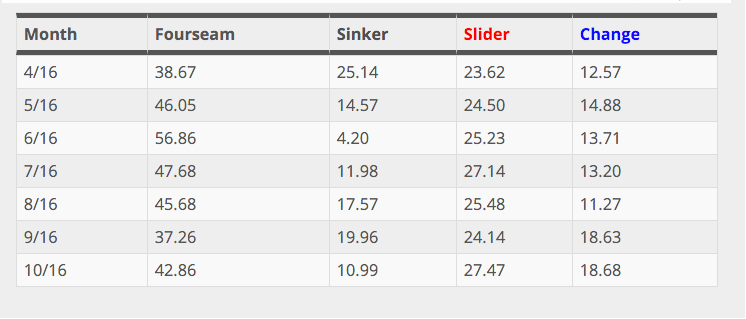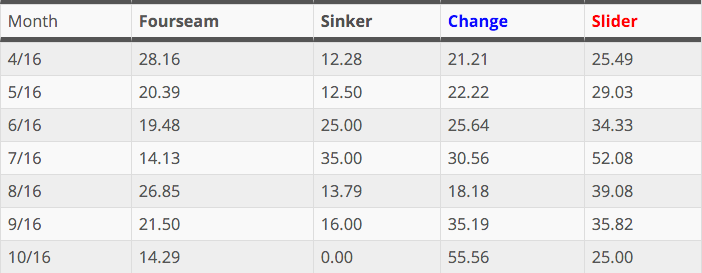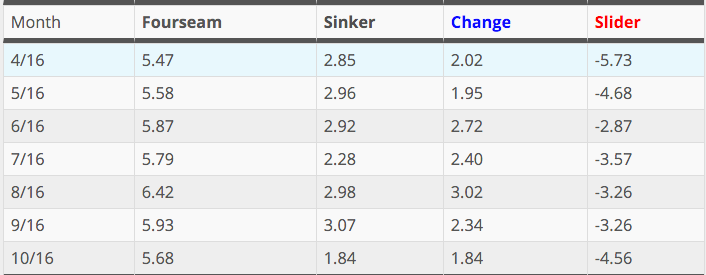In what has quickly become an early season tradition over the last couple seasons, the Red Sox starting rotation, once again, sucks. Outside of Chris Sale, none of the Red Sox starters have an ERA under five. The second best ERA in the rotation belongs to Drew Pomeranz, who’s currently supporting a healthy, robust 5.23 ERA (although to be fair, he’s also running a 3.22 FIP, so hurray for optimism?). Rick Porcello is getting knocked around the park (more specifically, knocked out of the park and into the second level), Eduardo Rodriguez is walking over 16 percent of the batters he faces, and the only thing that stands between Steven Wright and his destiny as an innings eater out of the bullpen is a few rehab starts from David Price.
Luckily, Chris Sale has been exactly as advertised so far. Through three starts totaling 21.2 innings, Sale is averaging over seven innings a start while putting up the following numbers: 1.25 ERA, 1.55 FIP, 36.7 K%, and a 6.3 BB%. He’s averaging roughly 12 K’s and two walks per nine innings. These numbers look especially important when you take into account that over the three games he’s pitched, the Red Sox have scored six runs. Six. The scores of games he’s pitched in are as followed: A 3-0 win over Pittsburgh, a 2-1 loss to Detroit, and a 2-1 win over Tampa. Granted, the Red Sox aren’t scoring runs for anyone, but having an ace like Sale at the top of the rotation gives them the luxury of getting away with some of these low scoring affairs.
For the suddenly offensively-stunted Red Sox, having Sale put up a career-best start has been one of the primary saviors of the early season. The biggest knock on Sale coming into the season was the decline in strikeouts, and he’s put that to bed in the early goings. At this rate, his K/9 would be the highest it’s been since he broke into the majors in 2010. Of MLB’s top-1o leaders in K/9, only Sale (who’s ranked 6th) has thrown over 20 innings this season. Fun fact: the current leader in K/9 is John Lackey, proving, once again, that small sample sizes are fun. It’s also worth mentioning that Sale’s 21.2 IPs are the second most of any starter this year, only 0.2 IPs behind Ervin Santana.
While the slider is what gets all the attention, Sale has actually returned more often to his change up, too. Early in the year, I wrote about how his decrease in strikeouts could possibly be related to his hesitance to throw the change, and that returning to it more often, given how effective it is, could be smart. We’re going to assume that Sale not only reads these articles, but takes them into account when game-planning, because look what we have here:
Sale is throwing his change up 23% of the time this season. Now let’s compare that with a month-by-month breakdown of last year’s pitches:
So, as you can see, he’s throwing it a bunch more this season. That’s obviously good news, because his change-up misses a lot of bats. Here’s the percentage of swing-and-misses that his change is generating so far this season:
Now here’s how his change fared last season:
So, October aside, his change has become a significantly more reliable strikeout pitch. Once you take a look at the movement on that pitch, you’ll understand why. Here’s a log of his change up’s vertical movement from last year:
And now, this year:
What we’re seeing so far is a change up with significantly more movement to it. Sale’s slider has always been his pride and joy, but having a changeup that’s almost as effective creates a whole different monster entirely. Here’s to hoping that he keeps these trends going in the right direction, because when your second-best pitcher is Drew Pomeranz, the Red Sox could use all the help they can get.
Photo by Winslow Townson – USA TODAY Sports






